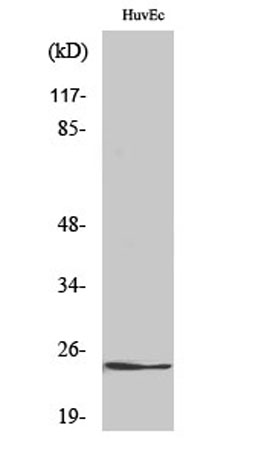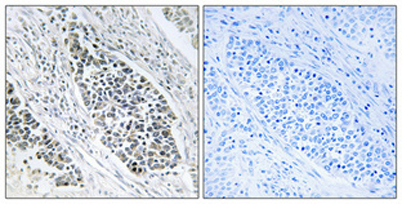









KDEL Receptor 2 rabbit pAb
 One-click to copy product information
One-click to copy product information$148.00/50µL $248.00/100µL
| 50 µL | $148.00 |
| 100 µL | $248.00 |
Overview
| Product name: | KDEL Receptor 2 rabbit pAb |
| Reactivity: | Human;Mouse;Rat |
| Alternative Names: | KDELR2; ERD2.2; ER lumen protein retaining receptor 2; ERD2-like protein 1; ELP-1; KDEL endoplasmic reticulum protein retention receptor 2; KDEL receptor 2 |
| Source: | Rabbit |
| Dilutions: | Western Blot: 1/500 - 1/2000. Immunohistochemistry: 1/100 - 1/300. Immunofluorescence: 1/200 - 1/1000. ELISA: 1/20000. Not yet tested in other applications. |
| Immunogen: | The antiserum was produced against synthesized peptide derived from human ERD22. AA range:81-130 |
| Storage: | -20°C/1 year |
| Clonality: | Polyclonal |
| Isotype: | IgG |
| Concentration: | 1 mg/ml |
| Observed Band: | 24kD |
| GeneID: | 11014 |
| Human Swiss-Prot No: | P33947 |
| Cellular localization: | Endoplasmic reticulum membrane ; Multi-pass membrane protein . Golgi apparatus membrane ; Multi-pass membrane protein . Cytoplasmic vesicle, COPI-coated vesicle membrane ; Multi-pass membrane protein . Localized in the Golgi in the absence of bound proteins with the sequence motif K-D-E-L. Trafficks back to the endoplasmic reticulum together with cargo proteins containing the sequence motif K-D-E-L. . |
| Background: | KDEL endoplasmic reticulum protein retention receptor 2(KDELR2) Homo sapiens Retention of resident soluble proteins in the lumen of the endoplasmic reticulum (ER) is achieved in both yeast and animal cells by their continual retrieval from the cis-Golgi, or a pre-Golgi compartment. Sorting of these proteins is dependent on a C-terminal tetrapeptide signal, usually lys-asp-glu-leu (KDEL) in animal cells, and his-asp-glu-leu (HDEL) in S. cerevisiae. This process is mediated by a receptor that recognizes, and binds the tetrapeptide-containing protein, and returns it to the ER. In yeast, the sorting receptor encoded by a single gene, ERD2, is a seven-transmembrane protein. Unlike yeast, several human homologs of the ERD2 gene, constituting the KDEL receptor gene family, have been described. KDELR2 was the second member of the family to be identified, and it encodes a protein which is 83% identical to the KDELR1 gene product. Alternative splicing r |
-
 Western Blot analysis of various cells using KDEL Receptor 2 Polyclonal Antibody diluted at 1:1000
Western Blot analysis of various cells using KDEL Receptor 2 Polyclonal Antibody diluted at 1:1000 -
 Immunohistochemical analysis of paraffin-embedded Human lung cancer. Antibody was diluted at 1:100(4° overnight). High-pressure and temperature Tris-EDTA,pH8.0 was used for antigen retrieval. Negetive contrl (right) obtaned from antibody was pre-absorbe
Immunohistochemical analysis of paraffin-embedded Human lung cancer. Antibody was diluted at 1:100(4° overnight). High-pressure and temperature Tris-EDTA,pH8.0 was used for antigen retrieval. Negetive contrl (right) obtaned from antibody was pre-absorbe -
 Immunofluorescence analysis of A549 cells, using ERD22 Antibody. The picture on the right is blocked with the synthesized peptide.
Immunofluorescence analysis of A549 cells, using ERD22 Antibody. The picture on the right is blocked with the synthesized peptide. -
 Western blot analysis of lysates from HUVEC and COLO cells, using ERD22 Antibody. The lane on the right is blocked with the synthesized peptide.
Western blot analysis of lysates from HUVEC and COLO cells, using ERD22 Antibody. The lane on the right is blocked with the synthesized peptide.

 Manual
Manual